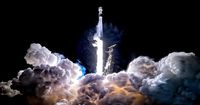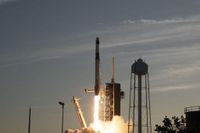SpaceX has made headlines once again with a remarkable achievement in rocket reusability. The Falcon 9 rocket successfully launched on March 21, 2025, at 11:49 PM from Vandenberg Space Force Base in California, marking a significant milestone in the aerospace industry. This operation was part of a top-secret mission designated as NROL-57, a project contracted by the U.S. National Reconnaissance Office (NRO). The mission aims at bolstering national security and intelligence capabilities through advanced reconnaissance.
In an impressive turn of events, this launch represented the second flight of the Falcon 9 rocket within a span of just nine days. This rapid turnaround broke the previous record for the Falcon 9, which was set at 14 days. The first launch occurred on March 11, 2025, when the same rocket successfully lifted off carrying NASA's SPHEREx space telescope and the PUNCH solar probes. Industry experts express that this achievement demonstrates SpaceX's growing capability in efficient launch operations and underscores the potential for increased frequency in space missions.
Following a successful ascent, the Falcon 9's first stage booster made a triumphant return, landing safely on Landing Zone 4 at Vandenberg Space Force Base. This was the fourth flight for this particular booster, which had previously supported several missions, including NROL-126 and other commercial payloads. Residents in nearby Santa Barbara, San Luis Obispo, and Ventura counties reported hearing a loud sonic boom as the booster touched down, a phenomenon commonly experienced during these high-speed returns to land.
The Falcon 9’s launch windows presented a weather forecast of broken clouds and moderate temperatures, with conditions being close to ideal for a rocket launch. The launch event attracted attention not only from industry personnel but also space enthusiasts eager to witness SpaceX's growing prominence in space exploration and satellite deployment.
SpaceX's latest mission, NROL-57, was part of a continued partnership with Northrop Grumman, providing critical reconnaissance capabilities through a constellation of satellites. The eighth batch of satellites for this reconnaissance mission is designed to enhance surveillance and imaging capabilities critical to national security.
Additionally, the successful deployment of NROL-57 has been positioned strategically within a series of launches planned at the Vandenberg Space Force Base. Upcoming missions include a Starlink communication satellite launch scheduled for March 24, followed by a dedicated mission by Firefly Aerospace to support Lockheed Martin's initiatives in rocket sustainability, named "Message in a Booster."
Overall, SpaceX's establishment of rapid launch frequencies and successful rocket recoveries represents a significant evolution in the aerospace domain, showcasing a bright future for ongoing private-public partnerships in the development of next-generation satellite systems for adaptation in both civilian and military applications.
As the industry gears up for more transitions towards increased launch frequencies, many are eager to see how SpaceX will innovate and address the demands of both governmental and commercial sectors. The occurrence of the launches amid a backdrop of evolving technology also raises questions about the implications for surveillance, space traffic management, and overall space security in the years ahead.
Whether future missions continue to push the boundaries of what is possible or rely on the growing constellation to enhance capabilities remains to be seen. Nonetheless, with the NROL-57 mission's success, one thing is certain: SpaceX is paving the way for a rapid response era in rocket launch operations and the advancements in capabilities for the National Reconnaissance Office are only likely to expand in the coming months.






